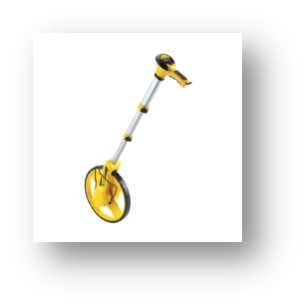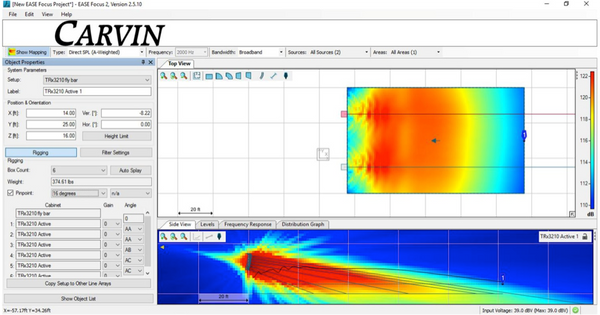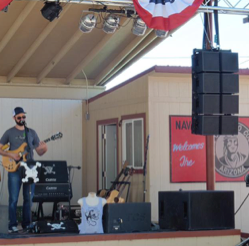-
Audio
-
Guitar
-
Bass
-
Blog
-
SALE
- Financing
- Support
- SINCE 1946
September 03, 2016
Throughout the course of my career in audio production I have provided audio systems for hundreds of indoor and outdoor events. While the tools I utilize are often very similar, the approach I have towards each situation can vary significantly. Let’s take a look at what goes into the logistics behind each and what you can do to improve your audio quality in each situation. This article will deal with preparing for an outdoor show and how to decide what speakers to use.
The majority of our work is done at outdoor venues, usually on grass fields or on asphalt parking lots. The very first thing that I do is measure the area that I need to cover with audio. Any typical measuring wheel, such as the one shown below, will work great for this. After measuring the area I also determine what angles of coverage I will need. By measuring and creating some plots, I get an idea of what speaker system will be required for the event.

With most outdoor events we are in a relatively open space, meaning few walls to cause reflections, which can be a benefit, providing the potential for better audio quality. But there is also the drawback of needing a larger audio system to cover the same area.
For example, you could have a stage area that is approximately 30 feet between the speakers and you would need to cover an audience area of about 100 feet in depth. You will need to address both the sound pressure level demands of the show and you will need the coverage to be as even as possible. We will assume a typical outdoor festival with a concert stage where music is the main purpose of the event. For this, you probably want to be somewhere around 90dBA (the “A” designates A weighting on the dB measurement) at the 100 foot point. Using the inverse square law, where sound drops 6dB every time the distance is doubled, you can calculate that you need to have a speaker system capable of sounding great at an SPL of at least 120dBA at 1 Meter from the speakers. 1 Meter is used, because that is the standard for Maximum SPL of a speaker in the specification sheet. The Carvin Audio TRx line of speakers has many choices to fill this requirement.
Doing the MATH: (skip this is you like, there are several apps and website calculators that do it for you)
The inverse square law: SPL2 / SPL1 = 10 x log(D1 / D2)2
Where SPL1 is the SPL in dB at the D1 distance and SPL2 is the SPL in dB at the D2 distance.
Note the 2/1 =1/2 that is the inverse part. The “( )2” is the square part. The 10 x log() part lets you use SPL numbers in the first part with distances in feet or meters.
In our example, we know SPL2, D1 and D2, so we solve for SPL1:
Your distances need to be in the same units, so we converted the 100 feet into 30.5 meters.
SPL1 = SPL2 / ( 10 x log(D1 / D2)2) = 90dB / ( 10 x log(1 /30.5)2 ) = 119.68 or 120dB
With only 30 feet between the speaker stacks, you probably don’t need to include a center fill speaker. This is because a high quality speaker system with 90 degrees of coverage will still sound good in the middle. With lesser quality speakers the horizontal coverage is not always smooth and therefore you may need to place a center fill speaker on the front lip of the stage to cover the first couple rows in the middle. With stages larger than 30 feet between the speakers, I always consider using center fill speakers even with the highest quality speakers in our inventory.
Shown below is a screen shot from EASE FOCUS II (acoustic modeling software) with a plot showing the coverage for six Carvin Audio TRX3210A boxes per side and aimed for 100 feet. With this setup we get a calculated maximum SPL of 109.5dBA at 100 feet which gives us 20dB of headroom above our target SPL. This would be a great start to an outdoor event.

After modeling the area to make sure we have the correct speakers to cover the listening area, we still need to consider the logistics behind using the speakers. In this instance, we have modeled a hung line array speaker system, but we need to get the speakers up in the air for the modeled coverage angle to work. Some speakers can be hung from truss, others are easily hung from a Genie style lift, while others can only be stacked on the ground or on top of subwoofers. This may be because of the speaker style, what is available to you for lifting the speakers, or what is possible at the event. For example, we had one show where the ground water table was so shallow we could not use truss or a Genie lifts because they would sink. Below you can see three different system options for deploying the same speaker. Of course in our example here we are flying the speakers for optimal sound quality and consistency from front to back of the venue. When flying the system the distance to the front audience is increased, but the distance to the back audience is the same. This helps even out the SPL of the coverage and it allows you to angle the system for optimum even coverage.



For your next outdoor event, consider taking a little extra time to measure the area ahead of time and bring the correct speaker system for your event rather than just piling speakers in front of the stage. You’ll get great results, probably bring less gear than normal and your fans will love your performance.
In the next installment of this series I will go into how to plan for indoor sound and then how we prepare for power distribution for both indoor and outdoor events.
About the Author:
Ryan Jenkins started providing audio services in 1989. His production company, Concert Sound Solutions, provides production for events throughout the Southwest United States. They currently have many Carvin Audio speakers in their inventory in addition to passive and active speakers from other top manufacturers.
November 11, 2025
"This Is An Underrated Sound System!" DJ Tech Tips reviews the Carvin Audio TRC400A 4000W Powered Column Array System in this video.
October 13, 2025
Carvin TRC Active Column Array System features and setup video. Watch this video to discover the features and benefits of our active column array sound system. TRC Powered Column Array Systems offer portability with high SPL levels that project up to 400’ with exceptional clarity. Unsurpassed high frequency and deep bass response will place the audience in the center of your performance. TRC Systems are scalable and are available in 2000W, 4000W, and 8000W models.
June 18, 2025
Carvin Audio teams up with Red Bull to provide audio for the VIP experience in Des Moines for the 2025 Soap Box Race Iowa. The TRC Active Column Array System was used for the event.
Sign up to get the latest on sales, new releases and more…
NoFraud Frequently Asked Questions
"Make a joyful noise unto the Lord all of the earth; make a loud noise and rejoice and sing praises. Sing to the Lord with the harp and the voice of the psalm." - Psalm 98:4-5
© 2025 Carvin Audio.
Carvin Corp.
POS and Ecommerce by Shopify
